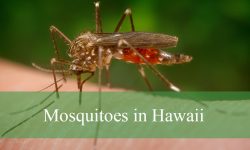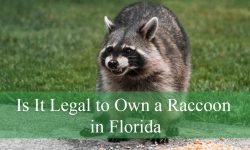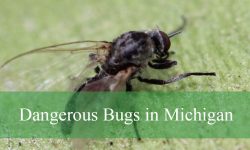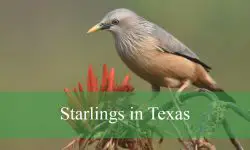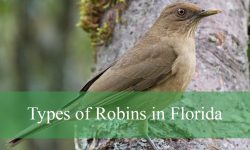Owls are some of the most fascinating and mysterious birds found in Vermont. With their silent flight, sharp eyes, and unique calls, these nocturnal hunters have captured the attention of bird watchers and nature lovers alike. Learning about Vermont’s owls is a great way to connect with the state’s rich wildlife.
Vermont’s diverse forests, wetlands, and open fields provide ideal homes for a variety of owl species. From the small and secretive Eastern Screech Owl to the powerful Great Horned Owl, each species shows its own distinct features and behaviors. Identifying these owls can be both challenging and rewarding when you know what to look for.
This article introduces 10 common owls found in Vermont, offering detailed descriptions, identification tips, and photos to help recognize these incredible birds in the wild. Spotting one during a nighttime walk or hearing their calls echo through the forest will be easier with this guide.
Common Owls Found in Vermont
Eastern Screech Owl
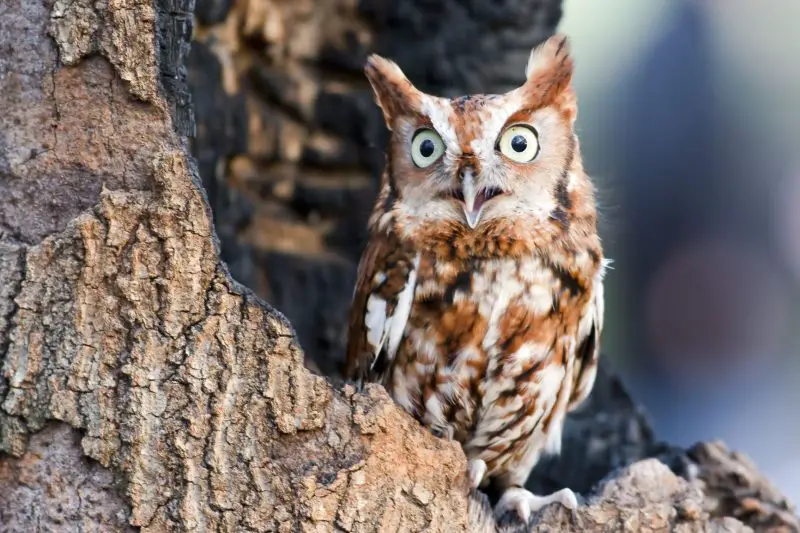
The Eastern Screech Owl is a small, stocky owl commonly found throughout Vermont. It has a rounded head with no ear tufts and exhibits two main color morphs: gray and reddish-brown. This coloration helps it blend perfectly with tree bark, providing excellent camouflage during the day when it roosts quietly. Their eyes are bright yellow, and their plumage is soft and mottled, aiding in their stealthy nature.
In terms of size, the Eastern Screech Owl is relatively small, measuring about 6 to 10 inches in length with a wingspan of 18 to 24 inches. Despite their small stature, these owls have powerful talons and a strong beak that help them capture a variety of prey. They are mostly nocturnal hunters, relying on keen hearing and eyesight to locate small mammals, insects, and occasionally small birds.
Eastern Screech Owls are quite adaptable and inhabit a wide range of wooded environments in Vermont, including suburban areas, parks, and forests. They nest in natural tree cavities or abandoned woodpecker holes, often using nest boxes provided by people. Their call is a distinctive trill or whinny that can sound eerie, especially at night.
A fun fact about the Eastern Screech Owl is that despite its name, its call sounds more like a trill or a whinny rather than a harsh screech. These owls are also known for their ability to mimic the calls of other birds, helping them avoid predators or communicate with mates.
Great Horned Owl
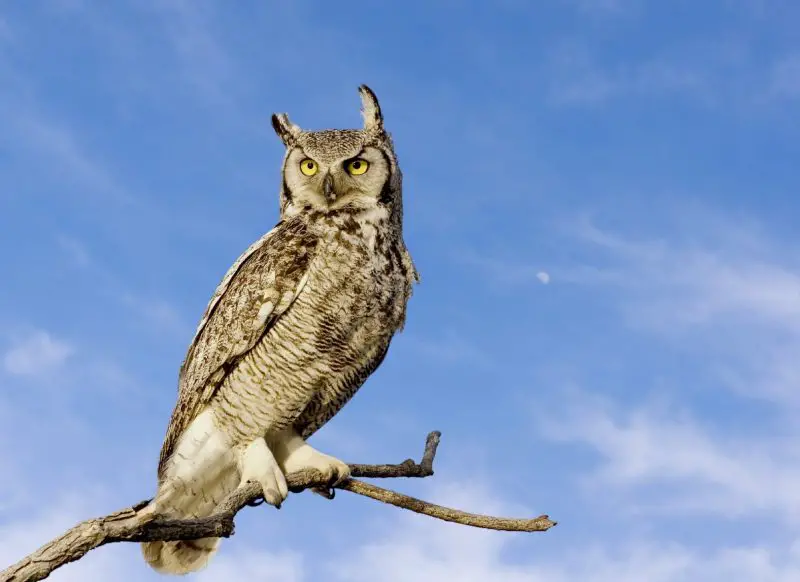
The Great Horned Owl is one of the largest and most powerful owls in Vermont. It is easily recognized by its prominent ear tufts that resemble “horns,” yellow eyes, and deep hooting voice. Its feathers are mottled gray-brown with a white patch on the throat, providing camouflage in forested areas. This species has a broad, rounded face and a fierce gaze that intimidates many other animals.
Measuring between 18 to 25 inches in length with a wingspan reaching up to 60 inches, the Great Horned Owl is formidable in size. It preys on a wide variety of animals including mammals like rabbits, raccoons, and even skunks, as well as birds and reptiles. Their strong talons and silent flight make them efficient nocturnal hunters.
In Vermont, Great Horned Owls prefer mixed woodlands and areas with open spaces for hunting. They are often found near forest edges, swamps, and even suburban neighborhoods. They use old nests of other large birds or natural tree cavities to raise their young, usually producing two to three chicks each season.
A fun fact about the Great Horned Owl is its tolerance for skunk odors; it can hunt skunks without being deterred by their smell, which is unusual among predators. They are also one of the earliest nesting owls in North America, sometimes starting to lay eggs as early as January.
Barred Owl
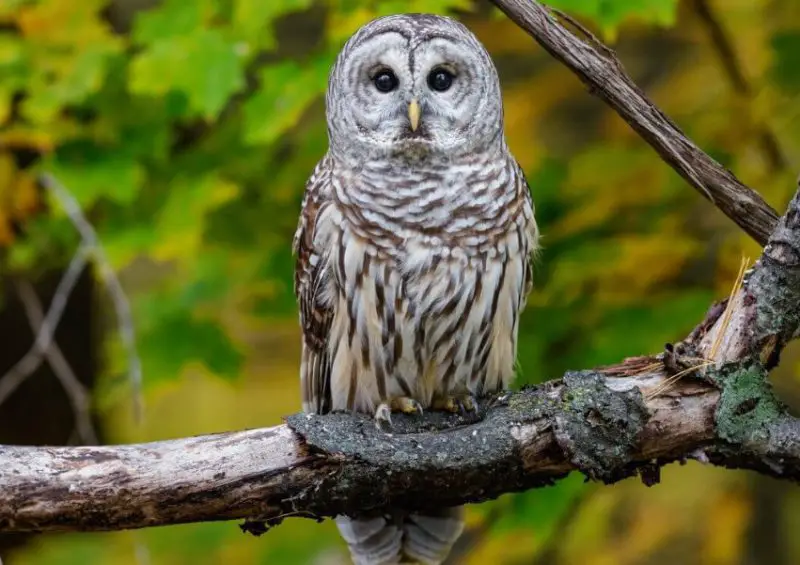
The Barred Owl is a medium to large owl well known for its distinctive hooting call that sounds like “Who cooks for you? Who cooks for you all?” Its plumage is brown and white with horizontal barring on the chest and vertical streaks on the belly, which gives the species its name. It has dark brown eyes, a rounded head without ear tufts, and a facial disk that helps focus sound.
This owl measures about 16 to 25 inches long, with a wingspan of 38 to 49 inches. Barred Owls hunt primarily at night but can be active during the day. Their diet consists mainly of small mammals, amphibians, and birds. They rely on stealth and acute hearing to locate prey in dense forest habitats.
Barred Owls thrive in mature forests and wooded swamps throughout Vermont. They prefer habitats with a mix of large trees and dense understory, which provide excellent cover and nesting sites. These owls nest in tree cavities or old nests built by other large birds such as hawks.
A fun fact about the Barred Owl is that it has been expanding its range westward into the Pacific Northwest over the last century, sometimes competing with the native Spotted Owl. In Vermont, it remains a common and familiar nocturnal presence in forests and near water.
Northern Saw-whet Owl
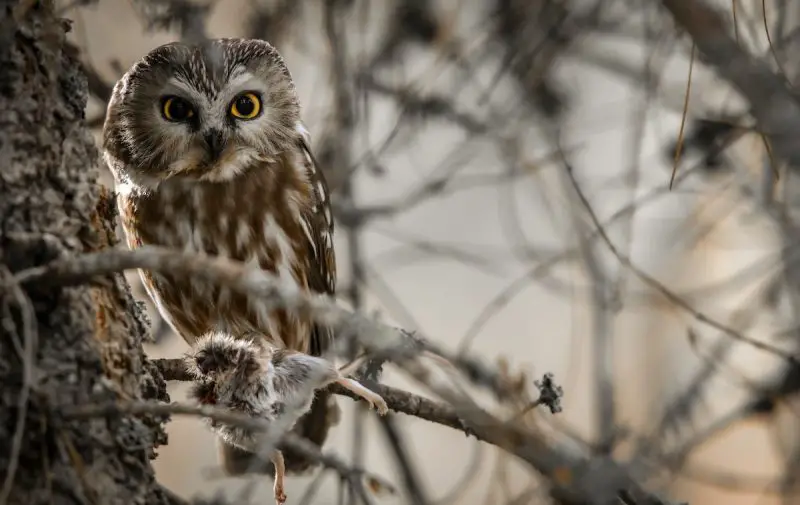
The Northern Saw-whet Owl is one of the smallest owls in Vermont, measuring only about 7 to 8 inches long with a wingspan of 16 to 22 inches. Its name comes from the sound of its call, which resembles a saw being sharpened on a whetstone. This owl has a round head without ear tufts, large yellow eyes, and a soft, buffy brown plumage with white spots.
Despite its tiny size, the Northern Saw-whet is a fierce predator that primarily feeds on small rodents like mice and voles. It hunts mostly at night, using its excellent hearing and silent flight to surprise prey. These owls are known to be somewhat secretive and can be difficult to spot in dense forests.
In Vermont, Northern Saw-whet Owls favor mixed or coniferous forests and wooded swamps. They nest in tree cavities or abandoned woodpecker holes and are often migratory, with some individuals moving southward during harsh winters. Their presence can be detected by their repetitive, high-pitched call.
A fun fact about the Northern Saw-whet Owl is that researchers often capture them during migration with mist nets and band them to track their movements, due to their small size and distinctive calls. They are sometimes mistaken for baby owls because of their size and large eyes.
Snowy Owl
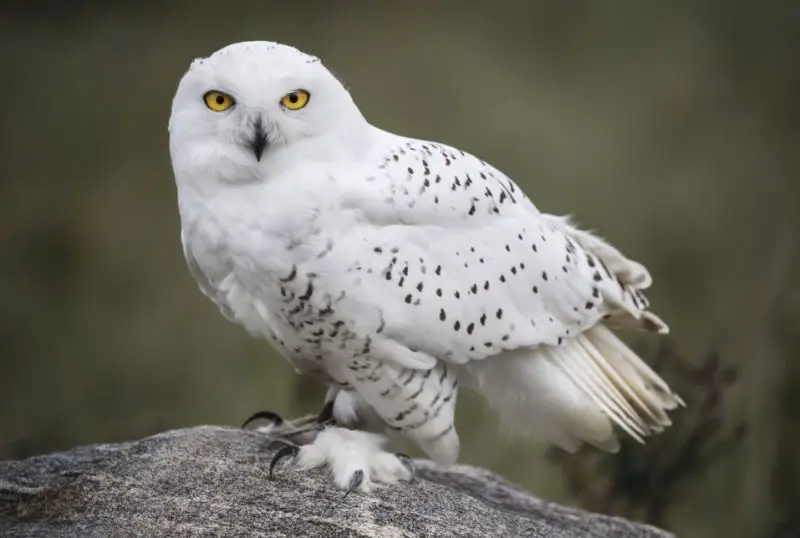
The Snowy Owl is a strikingly beautiful owl with mostly white plumage, accented by varying amounts of black or brown spots. It is one of the largest owls in North America and stands out with its bright yellow eyes and rounded head without ear tufts. The Snowy Owl is adapted for life in cold northern climates and is a rare but exciting winter visitor to Vermont.
Snowy Owls can measure between 20 to 28 inches long with a wingspan up to 60 inches. They hunt mainly during the day (diurnal) and prey primarily on small mammals such as lemmings and rabbits, using their sharp talons and keen eyesight to capture prey in open fields or tundra-like habitats.
In Vermont, Snowy Owls are usually seen during winter months when they migrate south from the Arctic in search of food. They favor open, treeless areas such as fields, airports, and coastal zones, where they can spot prey easily. Their presence in Vermont is often temporary but attracts much attention from bird watchers.
A fun fact about the Snowy Owl is that males tend to be whiter than females, who usually have more dark markings. Additionally, Snowy Owls are one of the few owl species that hunt during daylight, an adaptation to the bright Arctic summers they breed in.
Long-eared Owl
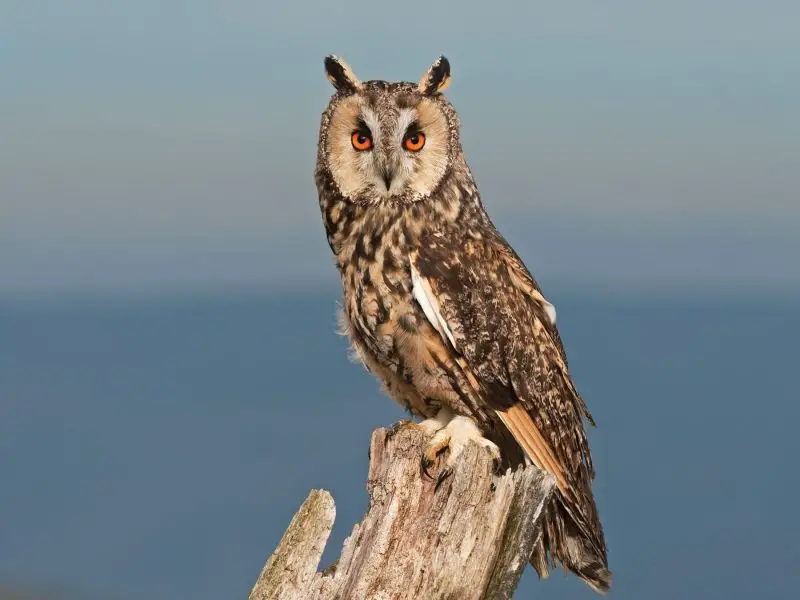
The Long-eared Owl is a medium-sized owl known for its prominent ear tufts, which are longer and closer together than those of many other species. Its facial disk is narrowly oval and orange-brown, with striking orange eyes. The plumage is mottled brown and buff, allowing it to blend seamlessly into dense coniferous and deciduous forests where it prefers to roost during the day.
Measuring about 13 to 16 inches in length with a wingspan of 35 to 40 inches, the Long-eared Owl is an agile and silent flyer. It mainly hunts small mammals such as voles, mice, and shrews, often flying low over open fields or forest edges. Its hunting style relies heavily on acute hearing and sudden bursts of flight to catch prey by surprise.
In Vermont, Long-eared Owls inhabit dense forests, especially mixed woodlands with thick understory, which provide excellent cover for nesting and roosting. They often nest in old stick nests built by hawks or crows, typically in dense thickets. Their population in Vermont is somewhat elusive due to their secretive nature and preference for heavily wooded habitats.
A fun fact about Long-eared Owls is their social behavior during winter: they often roost communally in dense tree clusters, with dozens of owls gathering together for warmth and protection, a rare trait among owl species.
Short-eared Owl
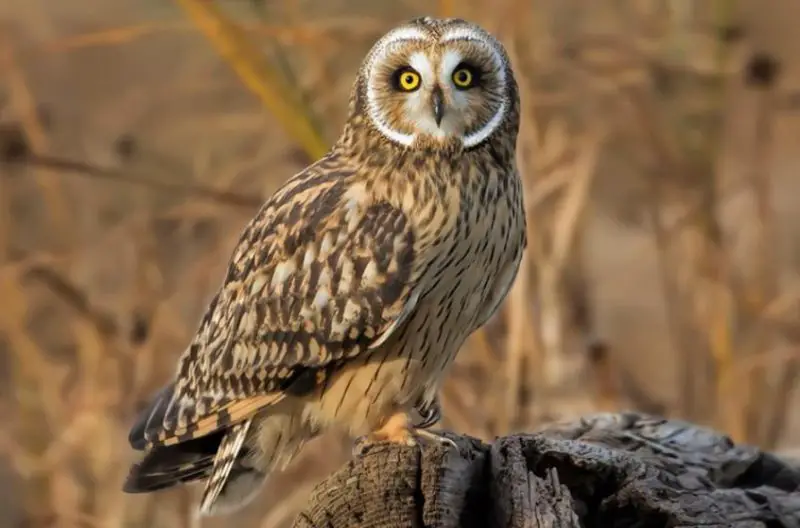
The Short-eared Owl is a medium-sized, ground-nesting owl recognizable by its short ear tufts that are often hidden, giving it a rounded head appearance. Its plumage is a mottled brown with buff and white, featuring distinctive dark eye patches and bright yellow eyes. This owl is often seen flying low and buoyantly over open fields and marshes during the day.
Measuring between 13 to 17 inches in length with a wingspan of 33 to 43 inches, the Short-eared Owl is a versatile hunter that feeds primarily on small mammals like voles, mice, and sometimes birds. Unlike many owls, it hunts mainly at dawn and dusk but can also be active during the day, especially in winter.
In Vermont, Short-eared Owls prefer open habitats such as grasslands, wetlands, and abandoned fields where their prey is abundant. They nest on the ground, often hidden in dense vegetation to avoid predators. Their numbers in Vermont fluctuate with prey populations, making them less commonly seen during some years.
A fun fact about Short-eared Owls is their striking, moth-like flight pattern as they hover and glide low over fields. This distinctive flight behavior helps birders identify them even from a distance.
Boreal Owl
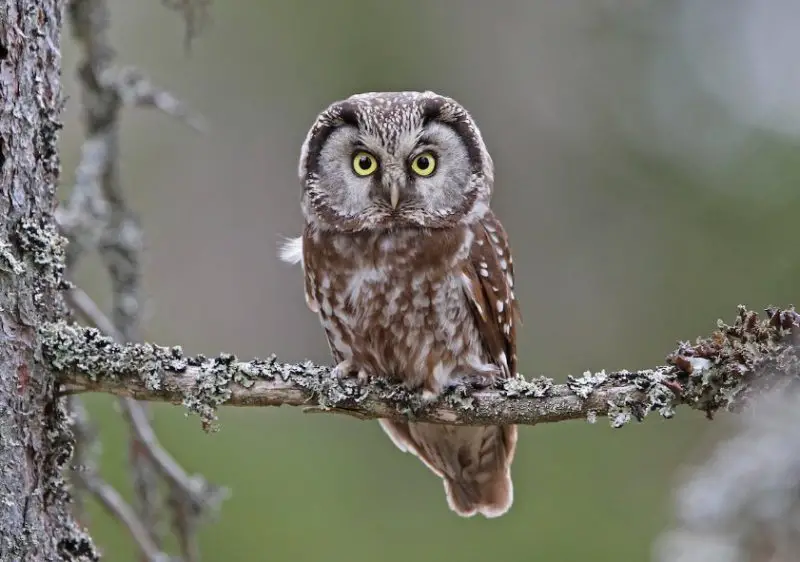
The Boreal Owl is a small, nocturnal owl with a rounded head and no ear tufts. Its plumage is mottled brown and white, with fine streaks and spots across the chest and belly. The face is pale with dark concentric rings around the yellow eyes, giving it a somewhat “spectacled” appearance.
Typically measuring 8 to 10 inches in length with a wingspan of about 20 to 24 inches, the Boreal Owl preys on small mammals, especially voles, as well as insects and small birds. It hunts mainly at night, relying on exceptional hearing to detect prey beneath snow or leaf litter.
In Vermont, Boreal Owls are rare and mostly found in the northern, dense coniferous forests, which resemble their preferred boreal habitat further north in Canada. They nest in tree cavities or abandoned woodpecker holes. Because of their secretive nature and low population, sightings are uncommon and highly prized by bird watchers.
A fun fact about the Boreal Owl is that it is one of the few owl species adapted to live in cold boreal forests, and it has a high-pitched whistle call that sounds almost like a peeping chick, which can be surprisingly cute for such a fierce predator.
Northern Hawk Owl
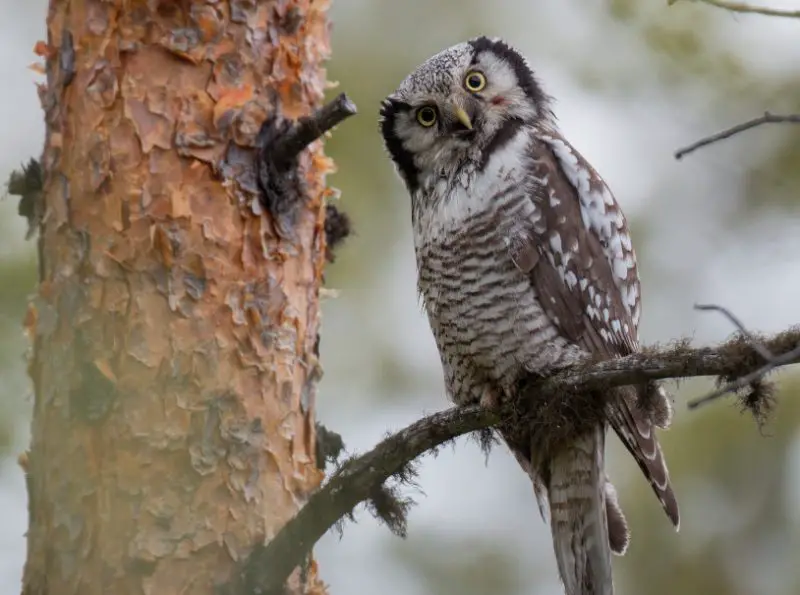
The Northern Hawk Owl is a medium-sized owl notable for its long tail and hawk-like shape. Unlike most owls, it is active during the day (diurnal) and often hunts by perching openly on tree branches or poles. Its plumage is brown with white spots on the head and back and horizontal barring on the chest, making it easy to distinguish.
Measuring about 15 to 19 inches in length with a wingspan of 30 to 36 inches, the Northern Hawk Owl feeds mainly on small mammals, especially voles and mice, capturing them with swift and precise strikes. It prefers open boreal forests and forest edges.
In Vermont, the Northern Hawk Owl is very rare and mostly seen during winter irruptions when northern populations move southward in search of food. It prefers dense coniferous forests but can sometimes be found in open areas adjacent to the forest. Its daytime hunting behavior makes it easier to spot than many other owls.
A fun fact about the Northern Hawk Owl is its unique combination of owl and hawk features, including its excellent eyesight and fast, agile flight, making it a highly efficient daytime predator.
Western Screech Owl

The Western Screech Owl is closely related to the Eastern Screech Owl but primarily found west of the Mississippi River. However, it has been recorded as a rare visitor in Vermont. It has similar size and appearance, featuring ear tufts, yellow eyes, and plumage that ranges from gray to reddish-brown with mottled patterns.
This owl measures about 6 to 10 inches long with a wingspan of roughly 18 to 24 inches. Its diet includes insects, small mammals, and birds, and it hunts mostly at night using stealth and acute hearing. Like the Eastern Screech Owl, it nests in tree cavities or nest boxes.
In Vermont, sightings of the Western Screech Owl are extremely rare and usually considered vagrants, possibly blown off course during migration. They prefer wooded habitats similar to those favored by the Eastern Screech Owl.
A fun fact is that the calls of Western and Eastern Screech Owls are quite similar but can be differentiated by birders with trained ears, as the Western species tends to have a more mellow trill.
FAQs about Owls in Vermont
What types of owls are commonly found in Vermont?
Vermont is home to various owl species, including the Eastern Screech Owl, Great Horned Owl, Barred Owl, Northern Saw-whet Owl, and Snowy Owl, among others.
When are owls most active in Vermont?
Most owls in Vermont are nocturnal and are most active during the night, especially at dusk and dawn. However, some species like the Snowy Owl can be active during the day.
Where do owls typically nest in Vermont?
Owls in Vermont often nest in tree cavities, abandoned nests of other birds, dense forests, or sometimes in nest boxes provided by humans.
What do owls in Vermont eat?
Owls primarily hunt small mammals such as mice, voles, rabbits, as well as birds, insects, and occasionally reptiles depending on the species.
Are owls in Vermont endangered or protected?
Most owl species in Vermont are protected by law due to their ecological importance. While some species have stable populations, others are rare and monitored closely.
Can you hear owls in Vermont year-round?
Owl calls are more commonly heard during breeding seasons in spring and early summer, but some species vocalize throughout the year, especially during mating and territorial displays.
How can I attract owls to my backyard in Vermont?
Providing nest boxes, preserving mature trees, and maintaining natural habitats with abundant prey can help attract owls to your property.

